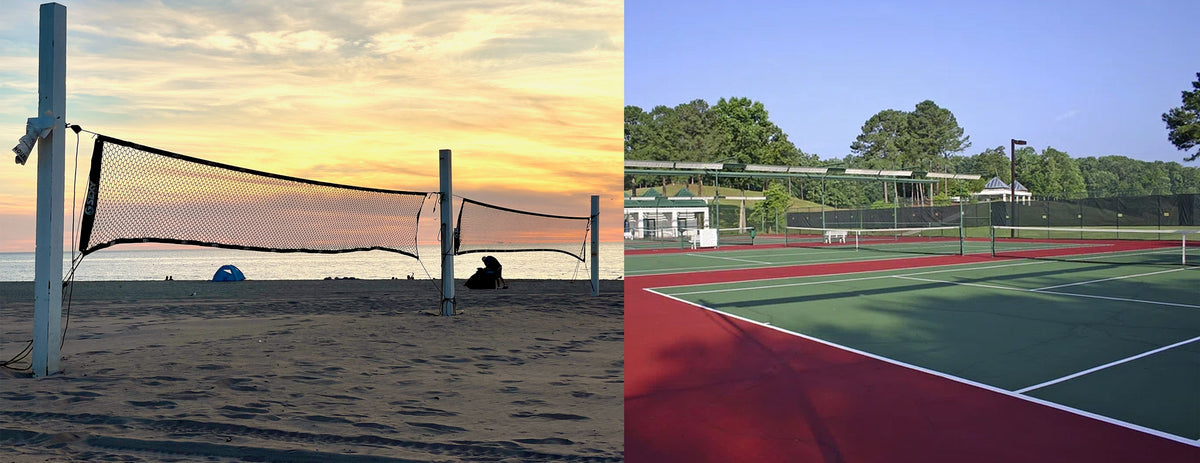

Introduction - Beach Tennis vs. Traditional Tennis: Spotlight on the Differences
Both beach tennis and traditional tennis showcase the competitive spirit, love for the racquet, and the thrill of the rally. While they share the core essence of the game, there are distinct characteristics that differentiate one from the other. Let’s delve into the nuances of these two racquet sports.For more on the rules check out the 2023 ITF Beach Tennis Rulebook.
The Playing Surface
Traditional Tennis: Depending on the venue, players find themselves competing on grass, clay, or hard courts. Each offers a distinct bounce and speed, shaping the game’s dynamics.
Beach Tennis: As you’d expect, beach tennis is played on sand, offering an entirely different challenge. The unstable nature of sand tests players' agility and reflexes.
The contrast in playing surfaces leads to distinct styles of play. On grass and hard courts, players can anticipate a faster game with more emphasis on serve and volley tactics. Clay courts slow down the ball and produce a high bounce, favoring baseline players with strong groundstrokes and endurance. In beach tennis, the sand makes movement more laborious, demanding higher levels of fitness and agility. Players often have to adapt their strategies to cope with the reduced mobility and unpredictable surface.
Equipment Used
Traditional Tennis: The game employs strung rackets and a rubber tennis ball encased in felt.
Beach Tennis: Here, players use solid paddles without strings. The ball is slightly depressurized, making its bounce characteristics different from the regular tennis ball.
The equipment differences significantly impact the gameplay. Traditional tennis rackets allow for a variety of shots and spins, influenced by string tension and racket head size. The solid paddles used in beach tennis, however, require players to rely more on placement and timing since creating spin is more challenging. The difference in balls also affects the speed and style of play, with beach tennis balls typically moving slower but requiring quicker reflexes due to the no-bounce rule.
Scoring System
Both sports follow the classic tennis scoring of 15, 30, 40, and game. Players aim for a 6-game set, with a tiebreaker at 6-6. A match can be the best of three or five sets, depending on the competition.
Game Dynamics
Traditional Tennis: Players often exploit the bounce, allowing them to strategize and position themselves better. Spins, drop shots, and lobs add variety to the rallies.
Beach Tennis: The sandy court allows no bounce for the ball. Players must strike the ball before it touches the sand, ensuring fast-paced action.
The game dynamics in traditional tennis can be complex, involving psychological warfare, where players attempt to outmaneuver and outlast their opponents. The ability to change pace, incorporate different spins, and use the entire court is crucial. In beach tennis, the dynamics shift to quicker reflexes, faster exchanges, and a high level of coordination, especially in doubles play. The lack of bounce means players must be constantly on the move, ready to jump or dive to keep the rally going.
Formats
Traditional Tennis: Matches can be singles or doubles, with both formats enjoying immense popularity.
Beach Tennis: Predominantly played in doubles, teamwork is crucial, emphasizing coordination and strategy.
The format of traditional tennis, whether singles or doubles, significantly impacts the strategy and physical demands of the game. Singles is a test of endurance, strategy, and mental toughness, while doubles requires teamwork, communication, and quick reflexes. In beach tennis, the doubles format dominates, highlighting the importance of team dynamics, shared strategies, and covering the court effectively together.
Match Duration
Traditional Tennis: Depending on the players and the match intensity, games can stretch from a quick one hour to marathon matches spanning five hours or more, especially in men’s Grand Slam events.
Beach Tennis: Generally, matches are brisk due to the no-bounce rule, and most conclude in under an hour, although the scoring system aligns with traditional tennis.
Physical Demands
Traditional Tennis: Movement dynamics depend on the court surface, with emphasis on stamina, agility, and technique.
Beach Tennis: The sand court adds an additional layer of complexity. Players often require explosive strength for quick movements and jumps on the unpredictable terrain.
The physicality of each sport caters to different athlete profiles. Traditional tennis players often showcase a blend of endurance, strength, and strategic thinking. They need the stamina to survive long rallies and matches, combined with the power for serves and groundstrokes. Beach tennis players, on the other hand, require a different kind of athleticism. They need explosive power for quick, short bursts of movement and the ability to maintain balance and coordination in the challenging sandy environment.
In Conclusion
Beach tennis and traditional tennis, while connected by lineage and basic rules, cater to different tastes and skills. Both games stand as a testament to the versatility of racquet sports. Whether you're intrigued by the grandeur and tradition of tennis or the beachy, energetic vibe of its sandy counterpart, both versions are bound to entertain and challenge you in their unique ways.
New Section: Beyond the physical and technical aspects, these sports also offer contrasting cultural and social experiences. Traditional tennis is often associated with its rich history, prestigious tournaments, and formal etiquette. It's a sport that combines grace, strategy, and athletic prowess, celebrated in grand stadiums around the world. Beach tennis, in contrast, has a more laid-back and festive atmosphere, often associated with beach culture and outdoor fun. It brings a sense of camaraderie and accessibility, making it a popular choice for social gatherings and community events.
Moreover, the global reach and professional structure of traditional tennis provide opportunities for players to pursue extensive careers, with pathways leading to world-famous tournaments like Wimbledon, the US Open, and the French Open. Beach tennis, while growing in popularity, still has a developing professional scene, offering a different kind of career path for athletes, often centered around beach sports and lifestyle events.
Finally, both sports offer valuable life lessons and benefits. From improving physical fitness and coordination to developing mental resilience and strategic thinking, players of both beach and traditional tennis gain skills that transcend the court. Whether it's the discipline and focus required in traditional tennis or the adaptability and quick thinking needed in beach tennis, players learn to navigate challenges, celebrate victories, and handle defeats, enriching their lives beyond the boundaries of the sport.
As both sports continue to evolve, they offer diverse and rich experiences for players and fans alike. Whether you prefer the classic courts of traditional tennis or the sandy arenas of beach tennis, both games promise a thrilling and rewarding journey in the world of racquet sports.
